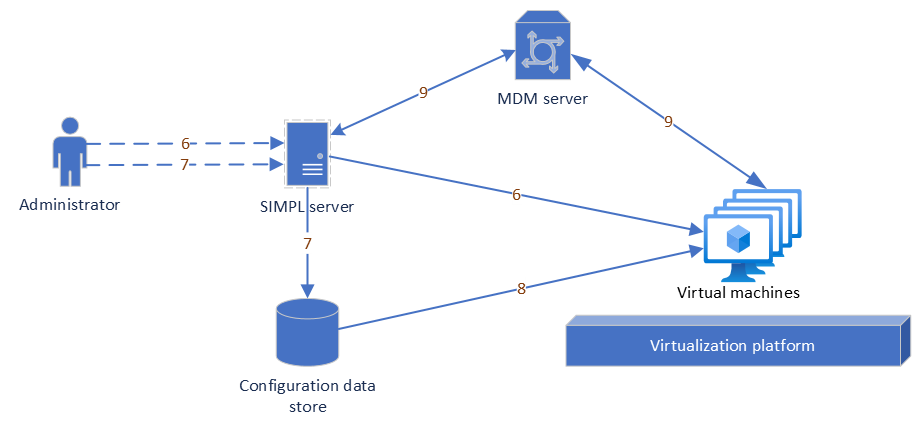To effectively plan and implement Rhino VM automation in your organization, learn about its architecture. This section explains Rhino VM automation components and describes how they work together to automate VM deployment, configuration, and life cycle management.
Rhino VM automation consists of the following components:
-
The VMBC tool, for creating a custom Rhino virtual appliance that contains Rhino TAS and the applications that you want to deploy.
-
A SIMPL server, for deploying VMs and managing VM life cycles.
-
An MDM server, for communicating information between the VMs and the SIMPL server.
-
A configuration data store (CDS), which is a Cassandra database for hosting the VM and Rhino application configuration information.
-
A virtualization platform, for hosting the deployed VMs.
As shown in the diagram below, during the Rhino VM automation process, first the software developer performs the following task:

-
Uses VMBC to create a custom Rhino virtual appliance that contains the Rhino platform and the applications to deploy.
|
|
In the diagrams on this page, the dashed lines indicate human actions, while the solid lines indicate data flow. The arrows indicate the directions of the actions or the data flow. |
Then as shown in the diagram below, the administrator performs the following tasks:

-
Uploads the virtual appliance to the SIMPL server.
-
Downloads configuration file templates from the SIMPL server.
-
Creates configuration files for the VMs and Rhino applications based on the templates.
-
Uploads the configuration files to the SIMPL server.
|
|
In your organization, a network engineer may be responsible for designing the virtual network and creating the configuration files. |
After this, the administrator performs the following tasks to deploy and configure the VMs, as shown in the diagram below:

-
Instructs the SIMPL server to deploy VMs to the target virtualization platform based on the virtual appliance.
-
Instructs the SIMPL server to push the configuration files to the CDS.
Once those tasks are completed, the automation works as follows:
-
Each deployed VM starts, automatically pulls the configuration files from the CDS, and then configures itself and the applications on it accordingly.
-
After the configuration, the VMs and the SIMPL server start to communicate through the MDM server. This allows you to manage the life cycle of the VMs on the virtualization platform.
In the Rhino VM automation process, step 6 is also called "Day 0". Step 7 and 8 are also called "Day 1". After the initial deployment, you may need to reconfigure the system or manage the life cycle of the VMs. These are often considered "post day 1" tasks.
